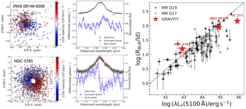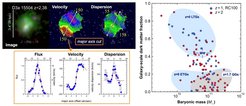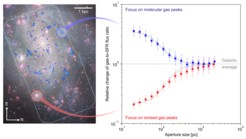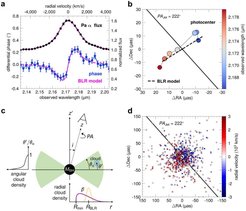News and Recent Results of the MPE Infrared/Submillimeter Group
A dynamical measure of the black hole mass in a quasar 11 billion years ago
January 2024

Tight relationships exist in the local Universe between the central stellar properties of galaxies and the mass of their supermassive black hole (SMBH). These suggest that galaxies and black holes co-evolve, with the main regulation mechanism being energetic feedback from accretion onto the black hole during its quasar phase. A crucial question is how the relationship between black holes and galaxies evolves with time; a key epoch to examine this relationship is at the peaks of star formation and black hole growth 8–12 billion years ago (redshifts 1–3).
Already the first ‘GRAVITY Wide’ stage of the GRAVITY+ project has opened the possibility of direct near-infrared interferometric measurements of black hole masses at such redshifts, for cases where a bright star close to the quasar can be used for adaptive optics correction and fringe tracking.
Hα results for SDSS J092034.17+065718.0 at z~2 show the clear signature of a thick disk Broad Line Region rotating around a black hole with a mass of 3.2 x 108 solar masses. In combination with NOEMA molecular gas data for the host galaxy, we find the black hole in this quasar to be under-massive compared to the local relation of black hole and stellar mass.
More information:
GRAVITY resolves the broad-line region in two more AGN
October 2021

Building on our pioneering work studying the broad-line region (BLR) of 3C 273 with GRAVITY, we have recently published the results of two more studies of the BLR in IRAS 09149-6206 and NGC 3783. Using the same technique and modeling as for 3C 273, we have resolved the velocity gradient of the BLR for both of these nearby AGN and through modeling have measured BLR sizes of 89 and 16 light-days and black hole masses of 1.1x108 and 4.8x107 solar masses respectively. With an increasing sample, we can begin to test the radius-luminosity relation, which is a strong correlation between the BLR size and AGN luminosity that was established through reverberation mapping, an indirect technique for measuring the BLR size. This relation is extremely important, especially at high redshift, as it allows for a simple measurement of the BLR size and then the black hole mass. Our current GRAVITY measurements, which directly resolve the BLR, largely agree with the local radius-luminosity relation (see figure) although the offsets are real and hint at important structural differences. Through our GRAVITY Large Program, we will continue to observe more AGN and further investigate these deviations that suggest a diversity of BLR geometries and properties and determine how they depend on other AGN parameters.
Finally, an exciting new direction has also emerged: by combining interferometry and reverberation mapping data, we can directly measure the geometric distance (D) to AGN. While GRAVITY determines the angular size (ra) of the BLR on-sky, reverberation mapping provides the physical size (rp) through time lags. As D = rp / ra, the two measurements give the distance. In another recent publication, we have applied this method to NGC 3783 where we find a distance of 40 megaparsecs, in excellent agreement with other independent methods. Applying this to multiple AGN over a range of distances could also lead to another measurement of the Hubble constant, whose value remains in dispute between supernovae and cosmic microwave background estimates.
More information:
- GRAVITY Collaboration et al. 2020, Astronomy & Astrophysics, Volume 643, A154
- GRAVITY Collaboration et al. 2021, Astronomy & Astrophysics, Volume 648, A117
- GRAVITY Collaboration et al. 2021, Astronomy & Astrophysics, Volume 654, A85
Evidence for Cored Dark Matter Distributions in Galaxies at z ~ 1–2
October 2020
Using a set of very deep, spatially resolved kinematic observations from the KMOS3D, SINS/zC-SINF, and NOEMA3D surveys and additional data from LBT/LUCI, we have performed a kinematic decomposition analysis to constrain the separate bulge, disk, and dark matter halo mass profiles for 41 star-forming galaxies at z ~ 1–2 (“cosmic noon”).
In agreement with previous work, we find the galaxies are generally baryon-dominated within Re. However, the larger sample reveals an anticorrelation between dark matter fraction and baryonic mass (or baryonic surface density), with lower dark matter fractions in the most massive and most dense objects. The very low fDM(Re) of these objects provides evidence that their dark matter halos have cored profiles, with lower central densities than predicted for the NFW halo distribution. Such cored halo profiles could be caused by interaction effects between the baryons and dark matter, such as dynamical friction from the rapidly inflowing material building up central bulges and black holes at this epoch, or AGN-driven feedback processes.

References:
- Genzel et al. 2020, ApJ, 902, 98 (http://ui.adsabs.harvard.edu/abs/2020ApJ...902...98G)
- Price et al. 2021, ApJ, in press (http://ui.adsabs.harvard.edu/abs/2021arXiv210902659P)
GRAVITY images the dust sublimation region in the nucleus of NGC1068
February 2020
A new GRAVITY data set of an active galaxy permits for the first time to image the nuclear hot dust in the sublimation region, i.e. the inner edge of the putative torus.

The observed properties of accreting supermassive black holes in active galactic nuclei (AGN) are determined by obscuring gas and dust. The size and structure of this obscuring, dust-emitting region in AGN is a long-standing issue: is it a torus or a disk, clumpy or in some other shape? What is the role of dust in winds and outflows? Direct observations of the nuclear dust structures are needed to reveal its nature and to study its role in unifying models of the varied AGN phenomena. However, circumnuclear dust in AGN is unresolved in single-dish images, causing a large uncertainty about the dust properties.
NGC 1068 at a distance of 14.4 megaparsecs is the prototypical Seyfert 2 galaxy. In particular, observations of NGC 1068 sparked the idea of a dusty torus surrounding a supermassive black hole. It has been the subject of numerous studies at high spatial resolution across the electromagnetic spectrum.
The near infrared is an ideal wavelength regime to study the dusty structures around AGNs as it is thought to trace hot dust just beyond the sublimation limit at its inner edge around the black hole. Our recent observations with the GRAVITY instrument on the European Southern Observatory Very Large Telescope Interferometer represent a giant leap in the study of the near-infrared emission. For the first time, we were able to reconstruct an interferometric image of the dust sublimation region (see figure) with an unrivalled resolution of 0.2 parscecs in the K-band. We find a thin ring-like structure of emission with a radius r = 0.24 ± 0.03 parsecs and an inclination i = 70 ± 5°, which we associate with the dust sublimation region. The observed morphology is inconsistent with the expected signatures of a geometrically and optically thick torus. Instead, the infrared emission shows a striking resemblance to the 22 GHz maser disc, which suggests they share a common region of origin. The dust structure and photometry are consistent with a simple model of hot dust at T ∼ 1,500 K that is behind AK ∼ 5.5 (AV ≈ 90) mag of foreground extinction. This amount of screen extinction could be provided by the dense and turbulent molecular gas distribution observed (e.g., by ALMA) on scales of 1 to 10 parsecs. Our new data represent another breakthrough result for GRAVITY on a classic AGN.
More information: Research paper: GRAVITY Collaboration: Pfuhl, O., Davies, R. et al. 2020, Astronomy & Astrophysics, Volume 634, A1
ALMA Reveals the Rapid Evolutionary Lifecycle of Star-Forming Regions in Galaxies
May 2019
Determining the physical processes controlling star formation in molecular clouds remains one of the main unsolved problems in astrophysics. New high-resolution observations of molecular clouds from ALMA and of the emission of young stars from the MPG/ESO 2.2 meter telescope for the nearby spiral galaxy NGC300 highlight the weak correlation of young stars and their parent clouds. This implies that the close correlation between molecular gas and star formation rate observed for whole galaxies and down to kpc scales – known as the Kennicutt-Schmidt or star formation relation – results from averaging over many star-forming relations. With a novel statistical model, we have shown that the observed decorrelation of young stars and molecular clouds holds valuable information on the time evolution of star-forming regions. For NGC300, we find that molecular clouds are short-lived (10 Myr or 1 dynamical timescale) and that a short period of active star formation (1.5 Myr) during which 2 to 3% of the cloud's mass is turned into stars releases sufficient stellar radiation and winds to disperse the parent molecular cloud. Star formation in molecular clouds proceeds very rapidly, yet highly inefficiently. This also explains the slow consumption of the galactic molecular gas reservoir by star formation of 1 Gyr in nearby galaxies because molecular gas has to evolve through many such cycles before it is fully turned into stars. We are now applying this analysis to a large number of galaxies in the nearby universe studied by the PHANGS collaboration and to first high-resolution observations of galaxies at high redshift during the peak of cosmic star formation.

More information:
A Spatially Resolved Quasar Broad-Line Region
November 2018

Knowing the structure, size, and dynamics of the broad-line regions (BLRs) near accreting supermassive black holes would allow scientists to constrain the inward and outward transport mechanisms and to infer the mass of the black hole. So far, however, directly measuring BLR properties was impossible because of the small physical size of the BLR, on the order of hundreds of light-days (corresponding to an angular size < 1 milliarcseconds). With GRAVITY, we have now, for the first time, spatially resolved (10 microarcseconds or ~ 0.03 parsec for a distance of 550 megaparsecs) a velocity gradient across the BLR of the quasar 3C 273. The gradient reveals rotation perpendicular to the jet, and is consistent with line emission from a thick disc of gravitationally bound material around a black hole of 3x108 M☉. We infer a disc radius of 150 light-days, compared to 100 to 400 light-days found previously with reverberation mapping (RM). Thus, GRAVITY provides both a confirmation of RM (at least for this one object) as the main previous method to determine black hole masses in quasars and a new and highly accurate, independent method to measure such masses. In an approved VLTI Large Program, we will extend this study to a (small) sample of local AGN, and we are exploring options to expand it to larger samples and higher redshifts with potential upgrades of GRAVITY.

These images show our first BLR detection in 3C 273. GRAVITY observations of the broad Paα line emission exhibit the characteristic differential phase S-shaped signature (Panel a). The on-sky position of the Paα photo center as a function of wavelength reveals a velocity gradient perpendicular to the jet direction (Panel b), which is a clear signature of rotation. The data are well-described by kinematic models of Keplerian rotation in a thick disk configuration viewed at low inclination (Panel c). In particular, the best-fitting model image on sky matches the observed spectroastrometric pattern (Panel d, compared to panel b). This analysis allowed for robust measurements of the BLR radius and black hole mass.
More information: MPE press release
Measurement of Gravitational Redshift in the Galactic Center
July 2018
Sagittarius A* (Sgr A*), the massive black hole in the center of our galaxy, is the closest of its kind and the largest in the sky. It is surrounded by a cluster of high-velocity stars, called the S-stars, whose trajectories are governed by the gravitational field of the black hole. We used the Very Large Telescope (VLT) instruments GRAVITY and SINFONI to follow the short (16-year) orbit star S2/S-02 during its recent pericenter passage in May 2018, and collected astrometric and spectroscopic data, respectively. For the first time, these joint data allowed for a robust detection of the combined gravitational redshift and transverse Doppler effect on S2/S-02.
Gravitational redshift is one of the three classic tests of general relativity. Einstein's theory foresees that due to gravitational time dilation, a light beam is stretched to longer wavelengths by a gravitational field. The change in the wavelength of light from S2/S-02 is inconsistent with Newtonian predictions and in excellent agreement with Einstein’s general theory of relativity. On a technological level, the success of this measurement with GRAVITY/VLT opens the door to an entirely new type of laboratory to probe and test the theory: the Galactic Center.

More information: GRAVITY Collaboration, 2018A&A...615L..15G

















